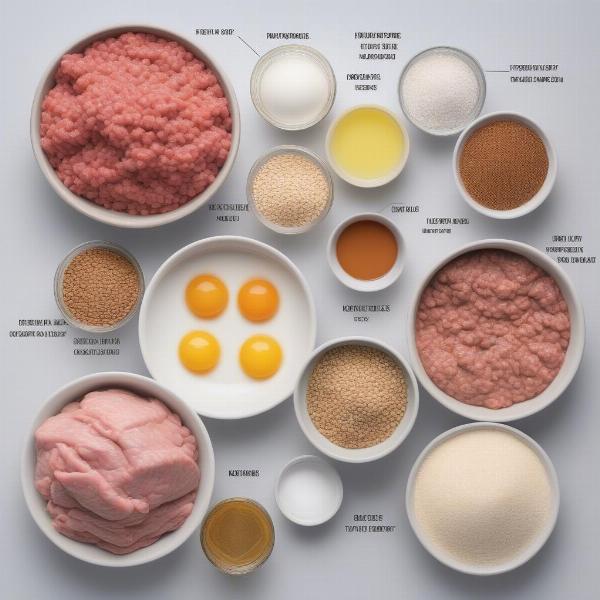Satin balls for dogs have gained popularity as a helpful tool for weight gain, especially for picky eaters or dogs recovering from illness. This high-calorie, palatable food can be a lifesaver for underweight dogs, providing them with the extra nutrients they need to thrive. But, as with any dietary change, it’s important to understand the recipe, benefits, and potential risks before incorporating satin balls into your dog’s diet.
What are Satin Balls and Why Use Them?
Satin balls are essentially a high-density, calorie-rich food supplement for dogs. They get their name from their smooth, satin-like texture after being thoroughly mixed. They are particularly useful for dogs who are underweight, struggling to gain weight, picky eaters, nursing mothers, or recovering from surgery or illness. These power-packed balls offer a concentrated dose of calories, protein, fat, and essential nutrients to help your canine companion put on healthy weight. However, they shouldn’t be a long-term dietary solution but rather a temporary boost.
 Satin Ball Ingredients
Satin Ball Ingredients
The Ultimate Satin Ball Recipe for Dogs
Here’s a tried-and-true satin ball recipe for dogs that you can easily prepare at home:
- 1 lb Ground Meat: High-fat ground beef, pork, or lamb are excellent choices.
- 1 cup Uncooked Oatmeal: Rolled oats or quick oats work well.
- 1/4 cup Wheat Germ: Adds valuable nutrients and fiber.
- 1/2 cup Total Cereal: Provides added vitamins and minerals.
- 1 Raw Egg: Contributes protein and healthy fats.
- 1/4 cup Vegetable Oil: Corn oil, canola oil, or olive oil are good options.
- 1 Tablespoon Honey (Optional): For added palatability and a touch of sweetness.
- Pinch of Salt (Optional): Use sparingly.
Instructions:
- Combine all ingredients in a large bowl.
- Mix thoroughly with your hands until everything is well combined and forms a smooth, sticky ball.
- Roll the mixture into balls of varying sizes, depending on your dog’s size and needs.
- Store the satin balls in an airtight container in the refrigerator for up to a week or freeze for longer storage.
How to Introduce Satin Balls to Your Dog’s Diet
When introducing satin balls, start slowly. Offer a small portion alongside your dog’s regular food to see how they react. Monitor your dog for any digestive upset, such as diarrhea or vomiting. Gradually increase the amount of satin ball offered as tolerated, replacing a portion of their regular food with the satin balls to prevent overfeeding. Consult your veterinarian for specific guidance on how many satin balls to feed your dog based on their individual needs and health condition.
Are There Any Risks Associated with Satin Balls?
While generally safe, satin balls can pose some risks if not used properly. High fat content can lead to pancreatitis in susceptible dogs. Raw eggs can carry the risk of Salmonella. Monitor your dog closely for any signs of digestive issues. Always consult with your veterinarian before introducing satin balls, especially if your dog has any underlying health conditions. They can help determine if satin balls are appropriate for your dog and recommend the correct portion size.
When to Stop Feeding Satin Balls
Once your dog reaches a healthy weight, gradually reduce the number of satin balls and transition back to their regular diet. Satin balls should not be a permanent food source. Maintaining a balanced diet with appropriate exercise is crucial for long-term health.
Conclusion
Satin balls can be a valuable tool for helping underweight dogs gain weight. This simple yet powerful recipe provides a concentrated source of calories and essential nutrients. However, remember to use them responsibly and in consultation with your veterinarian. By following the recipe and guidelines outlined in this article, you can help your furry friend achieve a healthy weight and thrive.
FAQ
- Can I use chicken in satin balls? Yes, cooked chicken can be used as an alternative to red meat.
- How long can I store satin balls in the freezer? Up to three months.
- Are satin balls suitable for all breeds? Consult your vet, as some breeds are prone to pancreatitis.
- Can puppies eat satin balls? Generally not recommended, as their dietary needs are different.
- What are some signs my dog is gaining too much weight? Difficulty breathing, lethargy, and reluctance to exercise.
- Can I add other ingredients to satin balls? Consult your vet before adding any additional ingredients.
- What if my dog doesn’t like satin balls? You can try different types of meat or add a small amount of peanut butter.
Suggested Further Reading on ILM Dog
While we haven’t found any directly related articles at this time, we encourage you to explore our website for valuable information on dog nutrition, health, and care.
About ILM Dog
ILM Dog (ilmdog.com) is your trusted resource for all things dog-related. We offer expert advice on dog breeds, health, training, nutrition, grooming, and much more. Whether you’re a first-time dog owner or a seasoned expert, ILM Dog is here to support you every step of the way. From choosing the right breed to understanding your dog’s nutritional needs, we provide practical and reliable information to help you make the best decisions for your canine companion. Contact us today for personalized guidance: Email: [email protected], Phone: +44 20-3965-8624.